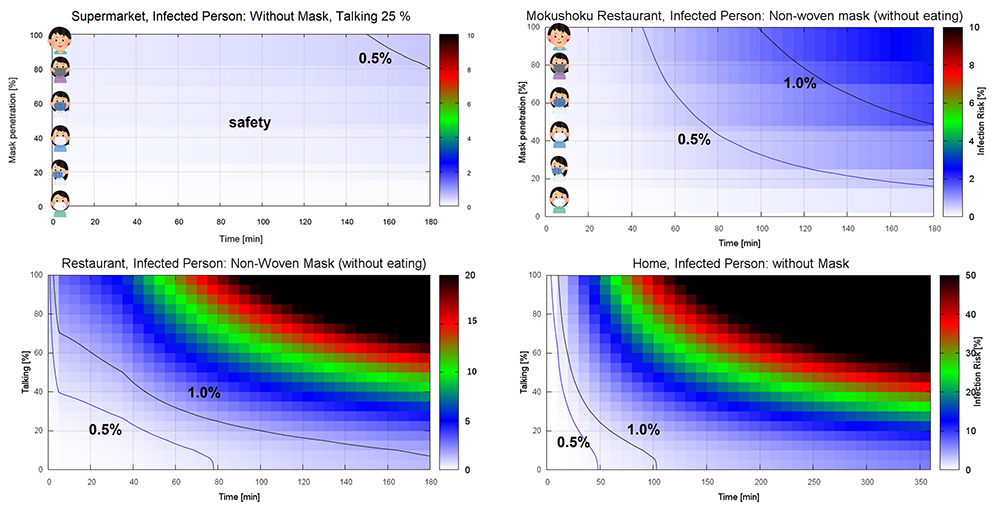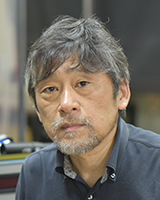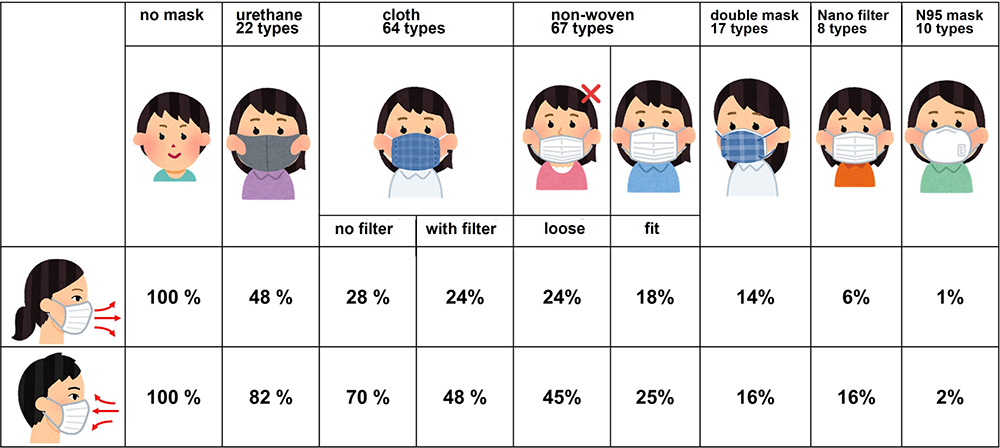
ここからコンテンツです。

Applying the science of air flow analysis to the prediction and prevention of viral droplet infection
Akiyoshi Iida

Professor Akiyoshi Iida conducts research using fluid dynamics (aerodynamics) to study the phenomenon of sound generated by airflow. To date, his research achievements include helping to reduce the operating noise of automobiles and bullet trains. In 2020, the research led to an unexpected breakthrough in demonstrating the efficacy of wearing masks, which was hotly debated at the time. Moreover, by evaluating the performance of different masks and showing the risk of droplet infection in different spatial conditions, Professor Iida is making significant contributions to fighting viral infection.
Interview and report by Madoka Tainaka
Fugaku Supercomputer Simulations and Mask Experiments
Professor Iida reflects on what led to the opportunity: a March 2020 conversation with Professor Makoto Tsubokura (Kobe University, Riken) on the way back from a research conference.
"As the pandemic approached, we talked about how this wasn’t the time to be doing normal research," says Professor Iida. Professor Tsubokura was researching phenomena relating to automobile engine gasoline inflow.
"For decades, we had been engaged in joint research to address issues such as automobile noise reduction. Since we had a computer program for droplet movement, we thought it could certainly help contribute to preventing infection from droplets. While there are significant differences in conditions between engines and humans, gasoline and saliva, and the speed that droplets travel, the fundamental ideas and relevant calculations are the same," he says.
Coincidentally, at the same time, MEXT and Riken issued permission to use the computing resources of the Fugaku supercomputer (which was set to launch in 2021) on a trial basis in order to combat the novel coronavirus. With that, they decided to investigate how the virus spreads in the air.
Their focus was on mask efficacy. At that time, while manufacturers provided performance ratings for mask filters, there was no systematic evaluation of the effectiveness of actually wearing the masks. On top of that, at the time the WHO was not recommending mask usage for those without symptoms, believing that masks were not effective. So why were medical staff wearing masks if they weren’t effective? Was there an etiquette-based reason to wear masks when coughing? To answer these questions, Professor Iida and the team decided they would need to clarify what masks could actually do for us.
Performance of masks (measured values) (left) and experiment movie ( right)
However, the miniscule fibers of masks are measured on a micron scale, which would make it very challenging to calculate a realistic computer analysis including all conditions. To address this, they decided to conduct an experiment to obtain data prior to performing calculations with the Fugaku supercomputer.
"Droplet calculations were handled by Professor Tsubokura, while Kyoto Institute of Technology Professor Masashi Yamakawa examined how the virus moved in the air, and I oversaw the mask experiments. Coincidentally, Assistant Professor Tsukasa Yoshinaga was researching human pronunciation in my lab, and as he had just purchased a mannequin head for his research, we decided to put a mask on it to conduct experiments," says Professor Iida.
The experiments commenced in April. Through these experiments, Professor Iida and the team determined mask pressure loss (degree of breath resistance) and permeability. and modeled the mask by measuring how much droplets a person would expel while taking into account the gap between the face and the mask.
Showing Risks in a Variety of Cases
Receiving cooperation from companies such as Kajima Corporation and Daikin, the team then used a calculation method devised by Professor Tsubokura to conduct simulations on droplet spread in locations such as offices, elementary schools, hospitals, and train cars. Superimposing the experimental mask data was, the Fugaku supercomputer then calculated the degree of mask efficacy in each location using numerous cases.
As early as June, a video was created for presentation to the press showing the efficacy of non-woven masks, droplet spread from coughing and conversation at offices and restaurants, the efficacy of opening windows in train cars, and the efficacy of partitions. These results received extensive news coverage and were widely adopted to make the infection countermeasures.
"We were in a rush for about two months leading up to the first announcement because we wanted to quickly dispel public uncertainty over the efficacy of masks and what conditions affected the risk of infection. To be honest, there was some wishful thinking that the pandemic might be reined in by summer," says Professor Iida.
From June onwards, Professor Iida and the project team surveyed around 200 types of commercially available mask, and repeated simulations across various daily scenarios. As a result, by August, the project team had been conducted over 2,000 analyses.
"To be honest, 50% of these analyses were failures. The cause of the failures was rooted in the fact that, as opposed to models for vehicles, the droplets move slower and remain in the air longer. Despite this, thanks to the Fugaku supercomputer, we were able to progress the experiment quickly through a process of trial and error. Even if a calculation failed after coming up with an idea, we were able to keep our motivation since we could immediately move on to the next idea. This is what made our research possible," says Professor Iida.

They subsequently publicized numerous guidelines showing the efficacy of masks made from non-woven fabrics, gauze and urethane, the effects of double masking using non-woven fabric and urethane masks, and infection risk from speaking or singing loudly.
"For example, loudly conversing at restaurants or karaoke produces 10-14 times more droplets than regular conversation, so ample precaution is required.
On the other hand, our demonstration of mask efficacy created new issues, such as the peer pressure placed on people who would not wear non-woven fabric masks. Wearing a high-performance mask can sometimes lead to heat stroke, and also increases the amount of carbon dioxide in the mask, which increases the risk of anoxia.
To start, masks are only helpful when there is someone infected within the group, so for the most part, their purpose goes unfulfilled. Nonetheless, to reduce infection, it is best to wear a mask. Cloth masks are also effective to a certain extent, and I think it is important to continue to take reasonable measures based on each situation as long as the risk is present"
Experiments and Simulations in Conjunction
Professor Iida and the team are continuing their research into coronavirus countermeasures. Recently, an experiment that generates droplets using artificial vocal cords has shown that droplets significantly increase when the speaker converses by vibrating their vocal cords, compared to when their vocal cords do not vibrate. Based on this finding, the team applied a formula to determine infection probability, which examined the degree of virus inhalation required for infection, and showed the infection risk for each event per infected person.
"One hour in a karaoke bar increases the probability of infection by 25%. At 90 minutes, the risk rapidly increases, so when dining it is best to finish up as quickly as possible. In addition, we recently discovered that seat configuration at restaurants affects the infection risk potential."
In the future, the team intends to create computer models for the throat, respiratory tract, and lungs to investigate how the virus attaches and how infection spreads when inhaled. There will also be an investigation of vaccine efficacy.
"This research should prepare us for the next infectious disease. Ultimately, I would also like to continue with my main research on vehicles and wind turbines. In particular, my research into giant ocean-based wind turbines, which I began some time ago, is a challenging topic that will be essential to utilizing natural energy. That said, since the foundations use aerodynamics, the approach is the same.” Addressing the appeals of his research, Professor Iida says that “while not all of my research is immediately helpful to the world, the reward of fundamental research is that it can be applied to various issues."
Reporter's Note
Professor Iida was admitted to Toyohashi University of Technology after graduating from Tokyo Metropolitan College of Aeronautical Engineering (now Tokyo Metropolitan College of Industrial Design). With a desire to work with vehicles, upon graduation he began research at Hitachi Ltd., where he used aerodynamics to develop bullet trains.
"It was a good company, but with corporations, as the years go by, it is hard to do your own work, since you may move into a managerial position or the company may restructure. I thought it would be boring if I could no longer conduct experiments, so I moved to a university," says Professor Iida.
While his skills with experiments ended up helping to evaluating the performance of masks, his research intentions at the university were not solely focused on applications for society.
"If you study the fundamentals, it can end up being helpful in some way. I mean, at one point I found myself researching the flight of dragonflies. It’s difficult to know what that could lead to," says Professor Iida with a laugh. The fun of fundamental research is that it can lead to discovering problems that are shared across various phenomena.
空気の流れの解析を、ウイルス飛沫感染の予測と対策に役立てる
空気の流れによって音が出る現象について、流体力学(空気力学)を使って研究している飯田明由教授。これまで、自動車や新幹線の走行中の音の低減などに、研究成果を役立ててきた。2020年、この研究が思わぬことに役立つ。パンデミックの最中、注目のアイテムとなったマスクについて、その着用の効果を明らかにしたのだ。さらに、マスクごとの性能評価や、空間条件ごとの飛沫感染リスクなどを示すことにより、ウイルス感染症対策に大きく貢献している。
「富岳」によるシミュレーションとマスクによる実験
きっかけは、2020年3月、ある研究会の帰り道に、理化学研究所/神戸大学の坪倉誠教授と会話したことだったと、飯田教授は振り返る。
「パンデミックが迫るなか、通常の研究だけをしている場合じゃないだろうと話したんですね。坪倉教授は自動車のエンジンのなかにガソリンを吹き込むときの現象について研究をされていて、十数年にわたり、自動車の音の低減などをテーマに共同研究をしてきた間柄です。我々は飛沫の動きに関するコンピュータ・プログラムを持っていますから、飛沫感染の防止策に必ずや貢献できると思っていました。エンジンと人間、ガソリンと唾液、飛沫の飛ぶ速度など、条件こそ大きく違いますが、基礎的な考え方や計算すべき対象はまったく同じですからね」
ちょうど文部科学省と理化学研究所から、2021年から供用を開始するスーパーコンピュータ「富岳」の一部の計算資源について、新型コロナウイルス対策に試行的に活用するようにと、通達が出されたタイミングでもあった。そこで、空間のなかでウイルスがどう拡散するのかを調べることにした。
ここで焦点となったのがマスクの効果だ。これまでマスクに関しては、各メーカーによるフィルターの性能評価はあっても、マスク着用に関する性能評価は存在しなかった。しかも当時、WHOはマスクには効果がないとして、とくに症状のない人の利用を推奨していなかった。しかし、効果がないのならなぜ医療従事者はマスクをするのか。咳エチケットとしてのマスクの装着に意味はあるのか。こうした疑問を解き明かすため、マスクの性能を明らかにする必要があると飯田教授らは考えた。
しかし、マスクは繊維の目がミクロン単位と細かく、リアルな解析のために条件をすべてコンピュータに入れて計算するのは困難だ。そこで、マスクについては、富岳で計算する前に、実験でデータを得ることにした。
「飛沫の計算は坪倉先生、ウイルスがどう飛ぶかについては京都工芸繊維大学の山川勝史教授、そしてマスクの実験は私が担当しました。偶然、私の研究室で人間の発音について研究している吉永司助教が、自身の研究のために頭部のマネキンを購入した直後だったこともあり、これにマスクをつけて実験することにしました」
こうして4月には実験を開始。飯田教授らは、実験を通じてマスクの圧力損失(息苦しさ)や透過率を求め、顔とマスクの隙間を考慮しながら、人がどれだけ飛沫を排出するのかを計測して、マスクのモデル化に取り組んだ。
さまざまなケースでのリスクを明らかに
続いて、鹿島建設やダイキンなど企業の協力も得ながら、オフィスや小学校、病院、電車内などについて、坪倉教授の計算法を用いて飛沫の拡散のシミュレーションを実施した。そのうえで、マスクの実験データと重ね合わせて、それぞれの場所でマスクをするとどの程度の効果が得られるのか、数多くのケースについて富岳で計算して調べていった。
そして早くも6月には、不織布マスクの効果をはじめ、オフィスや飲食店での発話や咳による飛沫の拡散、電車内での窓開けの効果、パーテーションの効果などを、動画で見える化し、記者勉強会で発表したのである。これらの成果は、ニュースにも大きく取り上げられ、感染対策に広く活用されることになった。
「最初の発表まで約2カ月と急いだのは、マスクが有用なのか、どういう状況で感染するリスクがあるのか、皆が疑心暗鬼になっている状況を早く解消したいと思ったためです。正直、夏頃までにはパンデミックは収まっているだろうという希望的観測もありました」と飯田教授は語る。
6月以降も、飯田教授らは200種類もの市販のマスクを調べるとともに、日常のさまざまな場面に合わせてシミュレーションを繰り返した。その結果、8月頃にはプロジェクトチームが行った解析の数は2000ケースにも上ったという。
「実はそのうち半分は失敗でした。失敗の原因は、車と違って空気の流れの速度が遅く、飛沫が滞留するためです。それでも、富岳を活用できたおかげで、すぐさまTry & Errorができた。アイデアを考えて、計算して失敗しても、またすぐに次のアイデアにつなげることができたからこそ、モチベーションを保ちながら研究できたと思っています」
こうして飯田教授らは、不織布、ガーゼ、ウレタンと、マスクの素材ごとの性能を明らかにしてガイドラインを示したほか、不織布とウレタンマスクを二重にしたダブルマスクの効果、大声で話したり歌ったりした際の感染リスクなど、感染防止策に役立つ知見を次々に明らかにしていった。
「たとえば、飲食時やカラオケなどの大声での会話は、通常の会話と比較して飛沫数が10〜14倍にもなるため、十分な注意が必要です。
一方、我々がマスクの効果を示したことで、不織布マスクをしない人への同調圧力など、新たな問題も生じました。高性能なマスクをつければ、熱中症になる場合があります。また、マスク内の二酸化炭素量が増え酸欠のリスクが高まります。そもそもマスクというのは、集団のなかに感染者がいた場合に役立つもので、ほとんどは空振りなのです。それでも感染症を抑え込むためにはマスクはつけたほうがいい。布マスクにも一定の効果はありますし、こうした状況が長期にわたる以上、場面ごとに無理のない対策をしていくことが肝要だと思っています」
実験とシミュレーションの両輪で
飯田教授らのコロナ対策研究はいまも継続中だ。最近は、人工声帯を使った飛沫生成実験により、声帯が振動しない呼吸よりも、声帯が振動する会話の方が飛沫が大きく増えることを明らかにした。この知見をもとに、どれくらいウイルスを吸ったら感染するのかという感染確率を求める式に当てはめて、感染者が1名いた場合の各イベントごとの感染リスクを示した。
「カラオケ喫茶に1時間いれば、感染確率は25%と高確率になります。これが90分になると急激にリスクが高まるため、飲食はできるだけ短い時間で済ませたほうがいい。さらに最近では、居酒屋のどの席だと感染リスクが高いかといったこともわかってきました」
今後はさらに、コンピュータ上に喉、気道、肺などのモデルをつくって、ウイルスを吸い込んだ際にどこに付着し、どう感染が広がるのかを調べる予定だ。併せて、ワクチンの効果も調べていくという。
「こうした研究は、次の感染症への備えにもなるはずです。もっとも、そろそろ本業である風車や車の研究も並行して進めたい。とくに、以前から手掛けてきた洋上の巨大風車の研究は、自然エネルギーの利活用に欠かせないチャレンジングなテーマです。とはいえこれも、基礎の部分は空気力学を使うため、アプローチは同じです。すぐに世の中の役に立つ研究ばかりではありませんが、さまざまな問題に応用できるのが基礎研究の醍醐味なのではないでしょうか」と飯田教授は、自身の研究の魅力を語った。
(取材・文=田井中麻都佳)
取材後記
東京都立航空工業専門学校(現・都立産業技術高専)を経て、豊橋技術科学大学へ進学した飯田教授。乗り物に関わる仕事がしたいと、卒業後は日立製作所で新幹線の開発に空気力学を生かす研究に携わった。
「いい会社でしたが、企業の場合、年を取ると管理職につくかリストラされるかで、いつまでも自分で手を動かして続けるのは難しいんですね。実験ができなくなるのはつまらないと思い、途中で大学へ移りました」
その実験屋としての腕が、マスクの性能評価にも繋がった。一方で、大学では役立つ研究をしなければならないと思っているわけではないという。
「基本的なことさえ学んでおけば、いずれ役に立つこともある。私だって以前はトンボの飛翔について研究していたこともあります。それが何になるのかと言われても困りますけどね(笑)」と飯田教授。さまざまな事象に共通する問題を見出せるところに、基礎研究の面白さがあるのだろう。
Researcher Profile

Akiyoshi Iida
Akiyoshi Iida graduated from Tokyo Metropolitan College of Aeronautical Engineering (Current: Tokyo Metropolitan College of Industrial Technology), and then entered Toyohashi University of Technology(TUT) as 3rd course student. He received PhD degree in 1998 from TUT. He started his career at Hitachi, Ltd., Mechanical Engineering Research Laboratory and, After retiring from that company, he also researched at Kogakuin University from 2001 to 2008. In 2008, he has been working at TUT as a professor.
Reporter Profile

Madoka Tainaka is a freelance editor, writer and interpreter. She graduated in Law from Chuo University, Japan. She served as a chief editor of "Nature Interface" magazine, a committee for the promotion of Information and Science Technology at MEXT (Ministry of Education, Culture, Sports, Science and Technology).
ここでコンテンツ終わりです。

